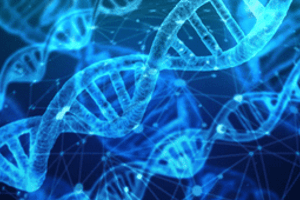Podcast
Questions and Answers
How does mismatch repair (MMR) function in DNA repair?
How does mismatch repair (MMR) function in DNA repair?
- Repairs single-strand breaks in DNA
- Corrects errors during DNA replication (correct)
- Removes damaged bases from DNA
- Creates crosslinks between DNA strands
Which mechanism removes damaged or mispaired nucleotides from DNA?
Which mechanism removes damaged or mispaired nucleotides from DNA?
- Base excision repair (BER) (correct)
- Single-strand break repair
- Crosslinks repair
- Mismatch repair (MMR)
What type of damage is caused by complete ruptures of both DNA strands?
What type of damage is caused by complete ruptures of both DNA strands?
- Base damage
- Crosslinks
- Single-strand breaks (SSBs)
- Double-strand breaks (DSBs) (correct)
What is the primary purpose of DNA repair mechanisms in cells?
What is the primary purpose of DNA repair mechanisms in cells?
Which DNA repair mechanism utilizes the sister chromatid as a template to fix double-strand breaks?
Which DNA repair mechanism utilizes the sister chromatid as a template to fix double-strand breaks?
Which type of DNA damage involves covalent bonds between DNA strands or between DNA and other molecules?
Which type of DNA damage involves covalent bonds between DNA strands or between DNA and other molecules?
Which of the following is an endogenous factor that can lead to DNA damage?
Which of the following is an endogenous factor that can lead to DNA damage?
What is the primary defect in the genetic disorder Ataxia telangectasia (AT)?
What is the primary defect in the genetic disorder Ataxia telangectasia (AT)?
Which DNA repair mechanism is responsible for eliminating bulky DNA lesions caused by exposure to UV light?
Which DNA repair mechanism is responsible for eliminating bulky DNA lesions caused by exposure to UV light?
What is the primary defect in the genetic disorder Xeroderma pigmentosum (XP)?
What is the primary defect in the genetic disorder Xeroderma pigmentosum (XP)?
Flashcards are hidden until you start studying
Study Notes
DNA Damage and Repair
DNA is constantly under attack from various exogenous and endogenous sources, which pose a significant threat to the integrity of the cell's genome. Eukaryotic cells possess efficient mechanisms to maintain their genome integrity by repairing any damage inflicted on the DNA molecule. This extensive network of DNA damage repair pathways ensures that the cell functions optimally and helps prevent the risk of developing diseases such as cancer.
Types of DNA Damage
There are several types of DNA damage that cells encounter daily, including:
- Base damage: Modifications to the base structure of DNA, such as methylation or the removal of protective methyl groups.
- Single-strand breaks (SSBs): Discontinuities in a single DNA strand.
- Double-strand breaks (DSBs): Complete ruptures of both DNA strands.
- Crosslinks: Covalent bonds between DNA strands or between DNA and other molecules like proteins.
Each type of damage necessitates different repair strategies tailored to address the unique challenges posed by each type of damage.
Mechanisms of DNA Repair
Cells employ several methods to repair DNA damage:
- Mismatch repair (MMR): Corrects errors during DNA replication when the wrong nucleotide is incorporated into the new strand.
- Base excision repair (BER): Removes damaged or mispaired nucleotides from DNA by a series of enzymatic reactions.
- Nucleotide excision repair (NER): Eliminates bulky DNA lesions, such as those created by exposure to UV light, by excising a small segment of DNA containing the damage site.
- Homologous recombination repair (HRR): Utilizes the sister chromatid as a repair template in cases of DSBs.
- Non-homologous end joining (NHEJ): Joins broken ends of DNA together without the need for a template, often utilized in response to ionizing radiation damage.
These repair mechanisms ensure that the cell maintains its genomic integrity.
Factors Affecting DNA Damage
Various factors influence the extent of DNA damage:
- Exogenous factors: Environmental elements like air pollution, certain foods, and industrial chemicals can introduce harmful compounds that cause DNA damage.
- Endogenous factors: Cellular processes like metabolism, mitochondrial activity, and inflammation can produce reactive oxygen species (ROS), which can oxidize DNA bases and create damage.
DNA Repair Disorders
Defects in DNA repair pathways can lead to various genetic disorders, such as:
- Ataxia telangectasia (AT): Results from a deficit in the ATM kinase, making individuals susceptible to cancer development.
- Xeroderma pigmentosum (XP)
Despite their importance in maintaining genomic integrity, dysfunctional DNA repair mechanisms can result in severe health issues, including an elevated risk of developing cancer.
Studying That Suits You
Use AI to generate personalized quizzes and flashcards to suit your learning preferences.




